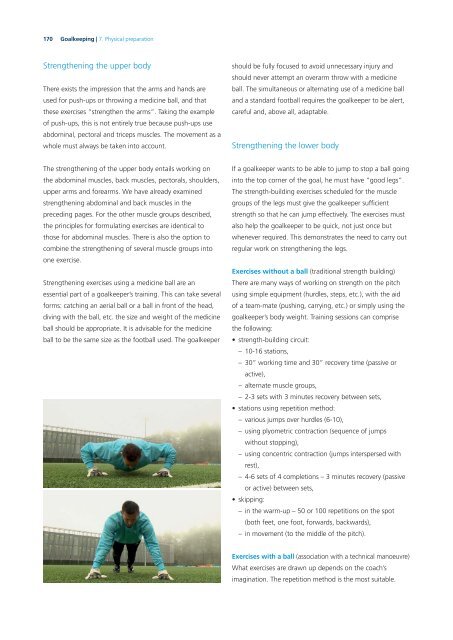Goalkeeping-bok
Goalkeeping-bok
Goalkeeping-bok
You also want an ePaper? Increase the reach of your titles
YUMPU automatically turns print PDFs into web optimized ePapers that Google loves.
170 <strong>Goalkeeping</strong> | 7. Physical preparation<br />
Strengthening the upper body<br />
There exists the impression that the arms and hands are<br />
used for push-ups or throwing a medicine ball, and that<br />
these exercises “strengthen the arms”. Taking the example<br />
of push-ups, this is not entirely true because push-ups use<br />
abdominal, pectoral and triceps muscles. The movement as a<br />
whole must always be taken into account.<br />
The strengthening of the upper body entails working on<br />
the abdominal muscles, back muscles, pectorals, shoulders,<br />
upper arms and forearms. We have already examined<br />
strengthening abdominal and back muscles in the<br />
preceding pages. For the other muscle groups described,<br />
the principles for formulating exercises are identical to<br />
those for abdominal muscles. There is also the option to<br />
combine the strengthening of several muscle groups into<br />
one exercise.<br />
Strengthening exercises using a medicine ball are an<br />
essential part of a goalkeeper’s training. This can take several<br />
forms: catching an aerial ball or a ball in front of the head,<br />
diving with the ball, etc. the size and weight of the medicine<br />
ball should be appropriate. It is advisable for the medicine<br />
ball to be the same size as the football used. The goalkeeper<br />
should be fully focused to avoid unnecessary injury and<br />
should never attempt an overarm throw with a medicine<br />
ball. The simultaneous or alternating use of a medicine ball<br />
and a standard football requires the goalkeeper to be alert,<br />
careful and, above all, adaptable.<br />
Strengthening the lower body<br />
If a goalkeeper wants to be able to jump to stop a ball going<br />
into the top corner of the goal, he must have “good legs”.<br />
The strength-building exercises scheduled for the muscle<br />
groups of the legs must give the goalkeeper suffi cient<br />
strength so that he can jump effectively. The exercises must<br />
also help the goalkeeper to be quick, not just once but<br />
whenever required. This demonstrates the need to carry out<br />
regular work on strengthening the legs.<br />
Exercises without a ball (traditional strength building)<br />
There are many ways of working on strength on the pitch<br />
using simple equipment (hurdles, steps, etc.), with the aid<br />
of a team-mate (pushing, carrying, etc.) or simply using the<br />
goalkeeper’s body weight. Training sessions can comprise<br />
the following:<br />
• strength-building circuit:<br />
– 10-16 stations,<br />
– 30” working time and 30” recovery time (passive or<br />
active),<br />
– alternate muscle groups,<br />
– 2-3 sets with 3 minutes recovery between sets,<br />
• stations using repetition method:<br />
– various jumps over hurdles (6-10),<br />
– using plyometric contraction (sequence of jumps<br />
without stopping),<br />
– using concentric contraction (jumps interspersed with<br />
rest),<br />
– 4-6 sets of 4 completions – 3 minutes recovery (passive<br />
or active) between sets,<br />
• skipping:<br />
– in the warm-up – 50 or 100 repetitions on the spot<br />
(both feet, one foot, forwards, backwards),<br />
– in movement (to the middle of the pitch).<br />
Exercises with a ball (association with a technical manoeuvre)<br />
What exercises are drawn up depends on the coach’s<br />
imagination. The repetition method is the most suitable.


